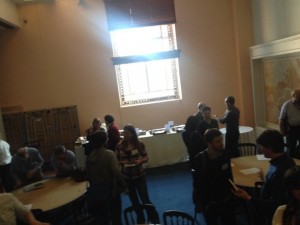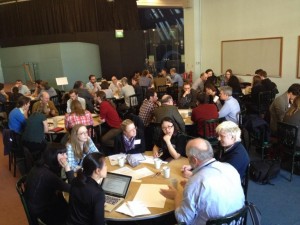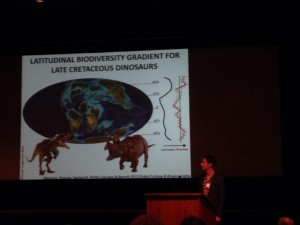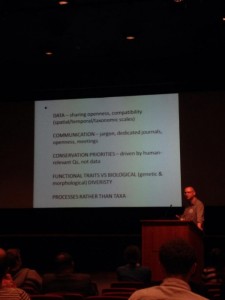Macroecology – scaling the time barrier
This was originally posted at: http://blogs.egu.eu/palaeoblog/?p=1178
If there was ever an overdue discussion in palaeontology, it was how we reconcile the differences in time scales when looking at different periods in our history. This is becoming increasingly more important as scientific research is being asked to have demonstrably greater ‘impact’ in terms of some social, economic, or environmental relevance, and for palaeobiologists and palaeoecologists, this means having some sort of notable effect on our changing world.
The day kicked off with Andy Purvis summarising what we actually mean by macroecology – I mean, it’s an impressive sounding term, but what is it scientifically? It’s actually varied quite a bit in time, with new tools and datasets meaning that our analyses have diversified and become more intricate, with the ability to answer and ask new questions about how species and populations diversify and change through time, especially with respect to the environment.
Andy offered some philosophical insight into the idea of empowerment – with increasingly sophisticated tools and quality of datasets, does the increasing ease of analysis often mean that we forget to ask why we’re trying to answer the questions we’re asking? Andy finished by discussing how integrated and synthetic macroecology is becoming, as the questions overlap, and we gather more datasets and realise how they interact and respond to each other.
The first keynote speaker was David Jablonski, discussing the role of intrinsic (e.g., organism biology) and extrinsic (e.g., climate) forces on biodiversity dynamics in time. David made a convincing argument for the role of climate, geography, species ranges and changing sea-levels for driving the origination and extinction dynamics of bivalves since the end-Cretaceous mass extinction. The question still remains though, can data on this scale be of use to inform conservation strategies to mitigate biodiversity loss in bivalves in the future? An exceptionally important question given that the only way we can make predictions is by observing the past, and additionally given the multiple ways in which humans are placing pressures on global marine environments through climatic disruption, shipping, trawling and ocean acidification.
We kicked off the session with a discussion on the difference between what we observe and what we want to infer – the latent data missing from what we’re observing. Lee Hsiang Liow placed this in the context of modelling palaeoecological and evolutionary dynamics. This was actually a really awesome talk, discussing how we can use probabilities to predict species level diversity in time based on our biased and incomplete knowledge of the fossil record – definitely something I’ll be looking to implement in future!
This led on to our first series of super-fast lightning talks. David Nicholson kicked things off by describing how different ways of accounting for sampling in the fossil record can produce very different pictures of biodiversity in the past, particularly in turtles. David Hawksworth shifted fields entirely to discuss the role of fungi, often overlooked, in answering large-scale ecological questions. Andres Baselga moved into his talk on how the spatial structure of animals has fractal properties, and what this means for biodiversity on a spatial and temporal scale. Anne Magurran discussed how historical trends in the structure of community assemblages can inform us about the future of biodiversity loss, followed by Ellinor Michel discussing how we get endemic (unique) species in the African ancient lakes. Viva Jones finished the session off with rather cool insight into how ecological records in Arctic lakes can provide us with information about possible carbon sequestration projects – a very timely and hot topic given the UKs recent move towards carbon capture and storage.
Next there was something a little odd, but fun. Everyone at the conference was asked at the beginning to self-identify which realm of ecology they belonged to – deep time, recent time, or modern ecology (or other, or a combination). We then had to ‘speed date’ with members of other groups and discuss our research and essentially learn as much as possible about other fields before moving on, at the sound of a penny whistle courtesy of Tori Herridge.
The afternoon sessions kicked off with a keynote from Kathy Willis, exploring how historical palaeontological records can be the key to the future, particularly with aspects like conservation biology. This was a very policy-relevant talk, with some cool real-world applications of palaeontology thrown in; for example, how fossil pollen records are helping to decide what plants should go where as part of the ‘re-greening’ of the Sahara. Willis was very praiseworthy of the value of more recent palaeoecological records, but when she mentioned (several times) that deeper time records where useful too, she didn’t really elaborate, and I’m sure many of us were thinking ‘really?’..

We moved on to the next session of lightning talks, with appropriately thunderous applause as many were superb! Graeme Lloyd launched into a discussion of the effects of adding fossil crocodiles to a tree of modern crocodiles, and how this influences their extinction risk. Spoiler: it influences it. Paul Barrett gave a nice historical overview of investigations into the coevolution of herbivorous dinosaurs and flowering plants, or angiosperms, finishing with a call for assistance to take the research into the modelling world. If anyone knows any good papers or software for analysing spatial or temporal associations between groups, then do get in touch! We then explored the role of climate on rates of diversification, before Andrew Johnson gave a talk and used actual fossils! He discussed the role of growth rates in scallops, and how this links to their extinction patterns, as well as factors like climate and nutrient availability. We shifted back to turtles then with Amy Waterson, looking at the effects of long-term environmental change on turtle diversity, as well as their ecology.
We then moved into something I rather enjoyed, breakout discussion groups. Goodness knows more of these interactive sessions are needed at conferences! I was fortunate enough to be grouped with some extraordinarily bright sparks including Mark Bell and Andy Purvis, and we discussed issues such as data standardisation and curation, accessibility, and understanding of methods between different groups of ecologists. The main theme running through it all was clearly some sort of training – in a world where ecology is becoming increasingly analytical, do we need better training for students in terms of methods and management of outputs. It was pretty awesome, and I’ve been informed that there will be a forthcoming publication summarising the many discussions, and how we can progress macroecological research as a single integrative entity.

The finale for the conference, excluding the wine of course, was a final round of lightning talks. I’m still not convinced by the utility of these – great for giving research sound bites, but very little time for detailed discussion, feedback, or questions. But overall they did demonstrate the breadth of research currently being undertaken across the various domains of ecology.

The session kicked off with a discussion about taxonomy, the system by which we name organisms, can play a role in defining global diversity patterns – something quite important given the lack of cross-field integration or understanding of how we define different taxonomic levels, especially species. My supervisor, Philip Mannion discussed his research on trying to unravel the history of the latitudinal diversity gradient – a prominent pattern in modern fauna, with species generally declining in diversity from the equator towards the poles. However, it doesn’t seem that this pattern has always been as smooth, or with such a prominent signal in the tropics when we look in detail at the fossil record. Mark Bell continued along this theme, using a variety of subsampling metrics to decipher Cretaceous tetrapod latitudinal patterns, finding that their richness peaks were often in non-equatorial zones, and maybe perhaps related to continental fragmentation or area. The penultimate talk from Isabel Fenton was about how we can look at the relationships between climate and the distribution of modern forams to look in detail at their historical patterns, particularly with large-scale climate disruptions like at the Paleocene-Eocene thermal maximum event. We finished with Thomas Guillerme providing an intriguing look into the role of missing data when you have a phylogeny composed of both living and extinct species, something that is quite often overlooked in combined analyses.

Overall, it was a quite enlightening day of lively discussion and informative talks, and my thanks go out to the organisers, sponsors, and attendees. Apparently there will be a forthcoming publication for the main discussion points, so watch this space!
Do check out the storify – many thanks to Paul Barrett for his awesome bitesize tweets for each talk! And hey, if one of the world’s top scientists can do it, the rest of you have no excuse 😉